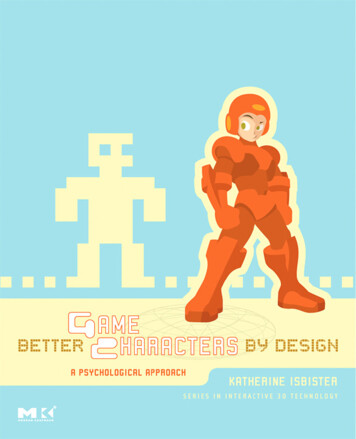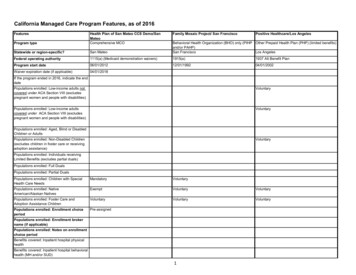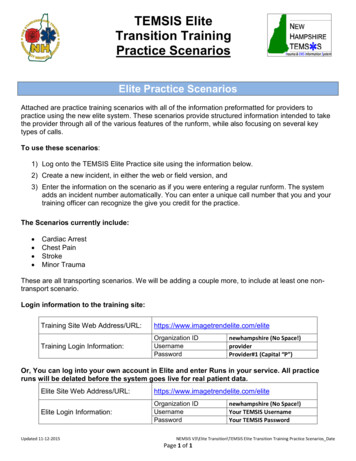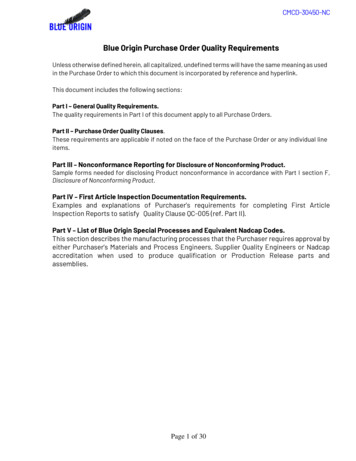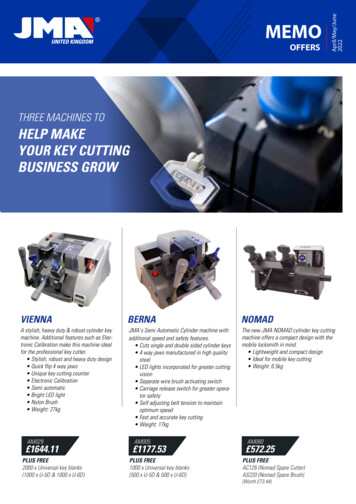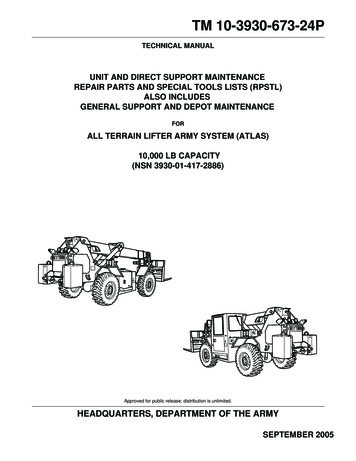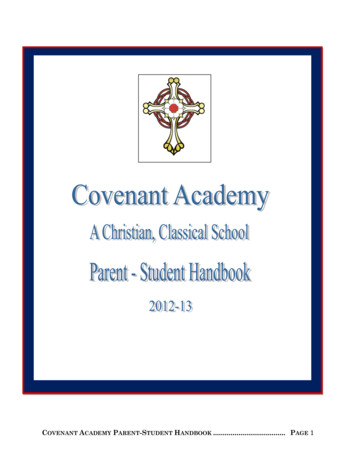
Transcription
This page intentionally left blank
Capstone Project SponsorsDetroit, MichiganSeattle, Washington & Detroit, MichiganPalo Alto, CaliforniaGrand Rapids, MichiganLansing, MichiganPlymouth, MichiganOkemos, MichiganMidland, MichiganChicago, IllinoisDearborn, MichiganDetroit, MichiganZeeland, MichiganLittleton, ColoradoFrederick, MarylandGrand Rapids, MichiganRedmond, WashingtonMountain View, CaliforniaEast Lansing, MichiganDetroit, MichiganDetroit, MichiganAuburn Hills, MichiganOkemos, MichiganChicago, IllinoisDetroit, MichiganRoyal Oak, MichiganAuburn Hills, MichiganBenton Harbor, MichiganPAGE N 0
Computer Science and Engineering CSE 498The Capstone ProjectsTime and location information is under this textbox in a light grey font as a placeholder. Please ignore this Iain.8:00 a.m.– Noon Engineering Building 1300 Hallway First FloorJames MarianiLuke SperlingInstructorsNote the change here.“Teaching Assistants” to“Instructors”.Dr. Wayne DyksenProfessor of Computer Science and EngineeringCSE498 Collaborative DesignCSE 498, Collaborative Design, provides the educational capstone for all students majoring incomputer science. Teams of students build software systems for a variety of clients.During the capstone experience, students design, develop, debug, document, and deliver a comprehensive software system, work in a team environment, become proficient with software development tools and environments, develop written and oral communication skills, build and administer computer systems, and consider issues of professionalism and ethics.Our clients are local, regional, and national including Ally Financial, Amazon, AnthropoceneInstitute, Atomic Object, Auto-Owners Insurance, Bosch, Delta Dental of Michigan, Ohio andIndiana, Dow, Evolutio, Ford Motor Company, General Motors, Google, Herman Miller,Lockheed Martin Space, Malleable Minds, Meijer, Microsoft, Mozilla, MSU Federal CreditUnion, PwC, Rock Family of Companies, Stellantis, TechSmith, United Airlines, Urban Science,Vectorform, Volkswagen, and Whirlpool.PAGE N 1
The Capstone ExperienceDesign Day Booklet Team PageAlly FinancialDigital Avatar AssistantAlly Financial is a financial services company based in Detroit,Michigan, operating as one of the largest car finance companies inthe United States. Ally has amassed an immense customer base,financing cars for over 4 million people and having 2 milliondepositors. Ally also offers online banking and online trading,bolstering the services they provide for their customers.Ally is a strictly digital company, offering no physical locationsfor customers. Because of this, Ally has been innovating the onlineservice field since their founding. As artificial intelligence (AI) hasadvanced, Ally has been exploring inventive methods of digitalcustomer service rooted in AI.Our Digital Avatar Assistant is a cutting-edge AI assistant thatprovides Ally customers with real-time communication relating totheir accounts, as well as custom-tailored financial advice.Customers interact with our assistant through a chatbotinterface embedded in Ally’s website. Users ask questions by typingor speaking with the assistant about a wide array of topics,including account information, budgeting, spending analysis, etc.To provide a lifelike experience, our assistant reacts withanimated movement and facial expressions depending on context,mimicking a conversation with a human.We use machine learning, natural language processing, and AIto analyze customer spending and budgeting habits to provide userspecific financial advice. Our Digital Avatar Assistant keeps track ofuser spending and provides reminders and warnings if the user is indanger of not meeting their spending goals.The Digital Avatar Assistant is developed using Rasa. Ourapplication uses Amazon EC2 for machine learning, Amazon S3 formodel storage, DynamoDB for conversation storage, and acombination of Amazon Transcribe and Amazon Polly forconversational functionality. The user interface is built with React.Michigan State UniversityTeam Members (left to right)Akhil AroraAnn Arbor, MichiganNate WoodNovi, MichiganXunran ZhouWuhan, Hubei, ChinaZach ArnoldFarmington Hills, MichiganPAGE N 2AllyProject SponsorsJared AllmondDetroit, MichiganDzmitry DubaravDetroit, MichiganDan LemontDetroit, MichiganHarish NaikDetroit, MichiganSusan NordDetroit, MichiganArvy RajasekaranDetroit, MichiganKevin WernerDetroit, Michigan
Design Day Booklet Team PageComputer Science and Engineering CSE498AmazonAmazon Web Services: AWSome Availability ZonesFounded in Bellevue, Washington in 1994, Amazon is aFortune 500 company that provides a variety of services tocustomers as the world’s largest online retailer and cloud servicesprovider.Customers using Amazon’s cloud platform, Amazon WebServices (AWS), can choose to break their application up into manyparts, each hosted in a different location (called an AvailabilityZone, or AZ). Such redundancy helps prevent service outages forcustomers.Distributed applications are spread across multiple servers,which need to communicate with each other for the application tofunction. This communication can take a significant amount oftime, and minimizing the delay can lead to a better user experience.Choosing which AZs to use to minimize this delay traditionallyrequires extensive manual testing.Our AWSome Availability Zones web applicationcontinuously and automatically measures the delay betweenAvailability Zones, allowing Amazon Web Services customers toeasily choose the fastest Availability Zones for their application,saving them time and money.AWSome Availability Zones provides customers with an easyto-understand visualization of the delay between Availability Zonesusing an interactive map with a familiar look and feel.Experienced Amazon Web Services customers can opt to useour AWSome Availability Zones system to explore more detailedviews of the network latency data, allowing them to answer specificquestions they have, quickly and seamlessly.Our software’s front end is built using Angular, and its backend uses Amazon Web Services Elastic Compute Cloud (EC2)instances to measure network latency between Availability Zones,which it stores in DynamoDB.Michigan State UniversityTeam Members (left to right)Wynton HuangAnn Arbor, MichiganJamison HeinerPlymouth, MichiganIris KimShanghai, Shanghai, ChinaJung ChakTaipei, Taiwan, TaiwanJake HoodDeWitt, MichiganAmazonProject SponsorsJennifer BeerDetroit, MichiganJeremy FryDetroit, MichiganGarret GawDetroit, MichiganDerek GebhardDetroit, MichiganErik KammanDetroit, MichiganTyler RozwadowskiDetroit, MichiganWilliam TannerDetroit, MichiganPAGE N 3
The Capstone ExperienceDesign Day Booklet Team PageAnthropocene InstituteAir Pollution Health Outcomes Forecasting ToolThe Anthropocene Institute is an organization that partnerswith researchers, governments, experts and investors to address oneof humanity’s most pressing concerns, climate change. Theorganization provides support to projects related to clean energy,anti-pollution efforts and climate innovation and brings down anypolitical or financial barriers they may experience.The Anthropocene Institute has turned its attention towardsair pollution in hopes of researching the effect that air quality has onpremature deaths and health complications, such as increasedasthma, infant mortality and lung cancer.Our Air Pollution Health Outcomes Forecasting Tool is anintuitive web dashboard that provides the public with a detailedanalysis of the air quality in their area, as well as the potentialresulting health effects.Users visit our dashboard and are presented with a map viewof the United States and a set of filters. These filters allow the userto pick a particular address or region to learn more about the airquality in that location.We use state-of-the-art machine learning techniques to makepredictions about air quality for every location in the United States.Whenever a request for air quality information is made we usehistorical air quality data as well as up-to-the-hour live air qualityreadings from sensors around the country to make accuratepredictions on the current air quality in any given location.Our tool is used by a wide variety of people, including peopletrying to find a safe and healthy place to live, as well as policymakerstrying to determine areas in need of assistance.The front end is developed with HTML, CSS and JavaScript.Our software is served via a Python Flask back end whichcommunicates data from our scikit-learn machine learning models.Our live data is retrieved from Purple Air Sensors.Michigan State UniversityTeam Members (left to right)Lukas RichtersFarmington Hills, MichiganTate BondGrand Rapids, MichiganLindsey BoivinNovi, MichiganHannah FranciscoBuffalo, New YorkZhendong LiuHefei, Anhui, ChinaPAGE N 4Anthropocene Institute 1Project SponsorsMicha BrownPalo Alto, CaliforniaRichard ChanPalo Alto, CaliforniaJason GwoPalo Alto, CaliforniaMichiya HibinoPalo Alto, CaliforniaRichard LeePalo Alto, CaliforniaFrank LingPalo Alto, CaliforniaCarl PagePalo Alto, California
Design Day Booklet Team PageComputer Science and Engineering CSE498Anthropocene InstituteElectricity Grid Planning ToolThe Anthropocene Institute is a non-governmentalorganization with the mission of utilizing science and technology toaddress the planet’s needs. It drives and facilitates innovation inclean energy to address the urgency of climate change. The Institutealso supports start-ups and universities to develop emerging anddisruptive energy technologies that are clean, safe and reliable.The Anthropocene Institute is interested in the possibility ofSmall Modular Reactors (SMRs) as a viable option for new sourcesof power generation in comparison to coal and gas plants that havesignificantly worse emissions that affect the atmosphere.SMRs, however, must be placed properly in power substationsbased on power generation, power outage occurrence rates, andpower consumption demands. Traditionally this would be doneentirely by hand, which is time-consuming, error prone, and makesit hard to quickly compare multiple placements.Our Electricity Grid Planning Tool is a web dashboard thatuses machine learning to automatically simulate SMR powergeneration and SMR placement. Our tool uses historical energyconsumption data to accurately predict the costs and benefits ofplacing an SMR at a particular power substation.Our web application provides an easy-to-use interface used byelectricity grid planners seeking to better understand the cost andbenefits for deploying SMRs. Users simply view specificsubstations, and our application provides them with statistics andrecommendations relating to the cost-benefits analysis of deployinga SMR in that area. Users can also easily compare two locations tomake an informed decision without wasting time with manualcalculations.The machine learning models were developed in Python withscikit-learn. The user interface is built on JavaScript, CSS andHTML with an Apache web server and Google Maps API.Michigan State UniversityTeam Members (left to right)Tyler SmithCharlotte, MichiganAmanuel EngedaEast Lansing, MichiganNafisa LenseniCanton, MichiganNic WellerJackson, MichiganAnthropocene Institute 2Project SponsorsRichard ChanPalo Alto, CaliforniaJason GwoPalo Alto, CaliforniaFrank LingPalo Alto, CaliforniaCarl PagePalo Alto, CaliforniaHunter PaulRochester, MichiganPAGE N 5
The Capstone ExperienceDesign Day Booklet Team PageAtomic ObjectStroodle: Learning Management SystemOperating for over 20 years, Atomic Object is a software designand development consultancy based out of the Midwest cities ofAnn Arbor, Grand Rapids and Chicago. Atomic Object has workedwith over 175 clients and created over 250 applications acrossdifferent industries, from tech startups to Fortune 500 companies.Learning management systems are utilized by manyeducational institutions to administer, track and deliver coursematerials and student work. Popular offerings provide manyfeatures to manage and engage in course activities but fail to deliverthem in a simple and intuitive application.Our Stroodle: Learning Management System provides tools forstudents and instructors alike to participate in online courses whilestreamlining the user experience.Students are provided a dashboard with a summary ofimportant information for all their enrolled courses. They can accessindividual course pages to interact with material prepared by theinstructor.Instructors manage their course by uploading documents, suchas reading materials or assignments, for their students to view. Theycan also organize upcoming events and deadlines for their studentson the course calendar.Easy quiz creation is supported to assess students. The resultsof these quizzes are available in a student’s gradebook along withscores of other graded assignments. Students are sent pushnotifications when instructors send out announcements.Our software supports all the key features of learningmanagement systems without any of the confusing aspects,streamlining course management and decreasing wasted time.The Stroodle front end is built using ReactJS and React Native.The back end is built using Node.js and Express.js, whichcommunicates with a PostgreSQL database.Michigan State UniversityTeam Members (left to right)Jake BosioWest Grove, PennsylvaniaShachi JoshiRochester Hills, MichiganSean OhareFarmington Hills, MichiganGabrie ItaliaShelby Township, MichiganPAGE N 6Atomic ObjectProject SponsorsMicah AllesGrand Rapids, MichiganJonah BaileyAnn Arbor, MichiganDylan GoingsAnn Arbor, Michigan
Design Day Booklet Team PageComputer Science and Engineering CSE498Auto-Owners InsuranceYard Wars: Weathering the StormAuto-Owners Insurance is a Fortune 500 companyheadquartered in Lansing, Michigan with over 48,000 licensedinsurance agents. Auto-Owners provides automotive, home, life,and business insurance to nearly 3 million placeholders in 26 states.As an insurance company, it is important for Auto-Ownersagents to be able to gather and analyze data regarding causes forclaims. This helps them better anticipate which clients could be atrisk of property damage and may need to submit a claim in thefuture.Our Yard Wars: Weathering the Storm project is a virtualreality application where storms are simulated on virtual residences.Any damage caused by the storms is viewable in real time and in firstperson. This data is gathered, stored and displayed on an externalwebsite for analysis.Users start by selecting the difficulty for the simulation, whichchanges the severity of the weather and number of trees that can beplaced. Then, the user is tasked with placing trees around theproperty in order to replicate an existing or planned residence. Oncethey have finished placing trees, the storm simulation begins.As the storm progresses, trees can fall and possibly causedamage to the home. Data about the simulation, including fallentrees and any damage caused, is sent to an external database forviewing and analysis on the website by Auto-Owners agents.Our Yard Wars is an engaging game that provides AutoOwners agents with useful information, assisting them withproviding high quality service.Our virtual reality software is developed in Unity and writtenin C#. We use a MySQL database to manage the data from thesimulation, and it is communicated using PHP to the website,which is hosted on the same server.Michigan State UniversityTeam Members (left to right)Carolus HuangXiamen, Fujian, ChinaGraham CornishCharlotte, MichiganBrandon ByiringiroOkemos, MichiganAuto-OwnersProject SponsorsTony DeanLansing, MichiganRoss HackerLansing, MichiganScott LakeLansing, MichiganJohn ReichenbachShelby Township, MichiganPAGE N 7
The Capstone ExperienceDesign Day Booklet Team PageBoschHardware in the Loop (HIL) Vehicle SimulatorBosch is a global engineering and technology company withroughly 395,000 employees worldwide. Founded in Germany in1886, Bosch is the world’s leading supplier of automotivecomponents.Currently, Bosch uses a Hardware in the Loop VehicleSimulator to correct errors with their software and perform tests.This system connects to specific hardware to simulate a vehicle onthe road. This hardware, however, is quite costly and therefore onlytwo systems are available to all Bosch engineers in North America.To resolve this, Bosch selected the PEAK PCAN USB Pro FD as alow-cost replacement for the previous hardware.Our Hardware in the Loop system reimplements the corefunctionality of Bosch’s previous system on the PCAN hardware.Our software allows the user to perform basic vehiclemaneuvers and operations such as steering, braking, acceleratingand more. The main functionality of our software system is adaptivecruise control (ACC), which users may engage and adjust at will.The user interface is designed to allow anyone with drivingexperience to control the simulation with ease. A graph isdisplayable to show the signals being sent to and from the PEAKhardware with their corresponding values.Above the controls for the vehicle is the dashboard. Thisdisplays the same basic information found in a real car including thecurrent speed, rpm, fuel level and more.Our software implements the same functionalities as theprevious vehicle simulator but runs on much cheaper hardware,cutting costs and allowing more systems to be used concurrently.The entire software system is written in Python 3. The frontend is built using the open-source toolkit wxPython, whilecommunication with the hardware is done using PCAN Basic API.Michigan State UniversityTeam Members (left to right)Justin ArmstrongBurton, MichiganLuke MonroeBrighton, MichiganAditya RajBokaro, Jharkhand, IndiaChristian ZawiszaAnn Arbor, MichiganAlan WagnerWestfield, New JerseyPAGE N 8BoschProject SponsorsSteve KoskiPlymouth, MichiganMatt LeePlymouth, MichiganTroy McCormickPlymouth, MichiganJohn NotorgiacomoPlymouth, Michigan
Design Day Booklet Team PageComputer Science and Engineering CSE498Delta Dental of Michigan, Ohio and IndianaSmart Benefit Plan Recommender EngineDelta Dental is an insurance company that provides dentalcoverage to more than 80 million Americans, spanning across all 50states, making them the largest dental care provider in the nation.Delta Dental takes pride in tailoring benefit plans to theircustomers’ needs, whether they are a small business, a family or anindividual. Before recommending the ideal benefit plan to acustomer, Delta Dental underwriters must aggregate data fromseveral sources and use their significant domain knowledge toproperly recommend a benefit plan. Creating personalized dentalplans for each customer takes a significant amount of time, as thereare many factors that need to be considered.Our Smart Benefit Plan Recommender Engine aidsunderwriters by automatically matching new customers withbenefit plans that are used by similar customers, with no input froman underwriter. Potential customers use our website to answer aseries of carefully crafted questions that are used to recommend abenefit plan.Our Recommender Engine uses advanced machine learningalgorithms to divide customers into groups that share manysimilarities. Each group is assigned an ideal benefit plan and whenthe system is given new data, it can easily provide arecommendation by mapping the new data to a group and itsrespective benefit plan.Our system makes the insurance shopping experience lessstressful for customers by allowing users to input their informationthrough an easy-to-use interface and providing immediate benefitplan recommendations and links to help them enroll in the plan.The front end of our system is written using Angular, while theback end is written in Python. The data is stored in a Snowflakedatabase, and the clustering models were developed in JupyterNotebook using the pandas and scikit-learn libraries.Michigan State UniversityTeam Members (left to right)Nicholas LenaghanDearborn, MichiganDerek NguyenAnn Arbor, MichiganNicole KellerSterling Heights, MichiganDelta Dental Data ScienceProject SponsorsMukundan AgaramOkemos, MichiganShikha MohindraOkemos, MichiganAyush SinghOkemos, MichiganArden KnollOkemos, MichiganPAGE N 9
The Capstone ExperienceDesign Day Booklet Team PageDelta Dental of Michigan, Ohio and IndianaMicrosoft Excel Data Extractor/ModelerServing more than 80 million Americans, Delta Dental isAmerica’s leading provider of dental insurance. To provide qualityservice, the company must host and leverage complicated data.Delta Dental maintains a significant number of sophisticatedExcel spreadsheets for various purposes. Comprehending thesespreadsheets requires significant industry expertise. Furthermore,extracting the industry knowledge from the spreadsheets to use inother applications often requires the development of computerprograms designed specifically for a single workbook, which is bothtedious and costly.Our Microsoft Excel Data Extractor/Modeler is a web-basedtool that removes the need for developing single-use computerprograms for extracting Excel data. Our system imports existingExcel workbooks and, with minimal user input, can extract therelevant information as well as the data hierarchies present in anExcel spreadsheet.Our web interface is designed to look and feel similar to Excel,but with specialized functionality that allows users to formallydefine data hierarchies and dependencies. These hierarchies canthen be visualized to understand the structure of an Excelspreadsheet, as well as to reformat an existing Excel spreadsheetinto an easier-to-understand form.The web application and resulting data visualizations andformatting help enhance employee comprehension of complexspreadsheets and add extensibility to the existing data. Our toolremoves the need for development of single-use programs, savingvaluable time for Delta Dental employees.Users can access the Data Extractor/Modeler through a webapplication that uses JavaScript and TypeScript within the MEANstack framework. We use X-SpreadSheet for our user interface andExcelJS to extract the data and formulas from Excel workbooks.Michigan State UniversityTeam Members (left to right)Ethan BransdorferHarrison, MichiganXochitl WeissOkemos, MichiganMorgan MundellBrighton, MichiganPeter RoNorthridge, CaliforniaPAGE N 10Delta Dental Knowledge ScienceProject SponsorsMukundan AgaramOkemos, MichiganJacob ErnstOkemos, MichiganChang (Charlie) LiuOkemos, Michigan
Design Day Booklet Team PageComputer Science and Engineering CSE498The Dow Chemical CompanyVirtual Computer Service EnhancementsHeadquartered in Midland, Michigan, Dow is a world leader inthe innovation, creation, and distribution of specialty chemicals,advanced materials, and plastics.As a large company with over 35,000 employees worldwide,Dow provides its employees with a service called Dow VirtualComputer, which is a virtual machine array. These virtual machinesgrant access to anyone with Dow credentials and a device withinternet connection to a physical Dow work computer without theuse of a VPN.Currently, Dow has a personal structure for assigning virtualmachines to their employees and clients on Microsoft Azure. Thismeans that each user has access to their own virtual machine.Dow is moving to a non-persistent state, meaning a singlevirtual machine’s resources can support multiple users, cuttingdown the required number of virtual machines running andtherefore saving money. In order to do this, there are many manualprocesses that need to be managed.Our Virtual Computer Service Enhancements softwareautomates the previously manual processes associated with thetransition to a non-persistent state by tagging user information,such as Dow identification number and login location, on eachvirtual machine. These tags help Dow with their billing process andthe location assignment of the virtual machines.Along with the automated tagging, our software generatesweekly reports of users with multiple virtual machines. Dow’ssupport teams use this data in their transition to a non-persistentstate.Our automation process is built within the Microsoft AzureCloud Computing Platform and runs through Azure AutomationRunbooks using PowerShell. The generated reports can be viewedthrough our mobile Microsoft Power App.Michigan State UniversityTeam Members (left to right)Arvid BrunsellWest Bloomfield, MichiganMark KistlerTroy, MichiganPatrick DoyleManitou Beach, MichiganDowProject SponsorsJeff NgafuaMidland, MichiganJeff VanDusenMidland, MichiganScott WayMidland, MichiganJunnan FuShenzhen, Guangdong, ChinaPAGE N 11
The Capstone ExperienceDesign Day Booklet Team PageEvolutioERP Kids: Wildlife ConservationEvolutio is a group of technology professionals that provideselegant solutions for complex business problems by leveragingtechnology in novel ways. Evolutio has partnered with the nonprofit group Elephants, Rhinos and People (ERP) to give back to theglobal community through a variety of programs.ERP is continually educating the world about wildlifepreservation through its various charities and social outreach. Partof their goals for educating includes reaching children in the 6-13year-old age demographic.ERP Kids: Wildlife Conservation is a top-down role-playinggame that allows the player to live as a wildlife ranger on theDinokeng Reserve in South Africa. The game is offered on all mobiledevices and designed to teach elementary and middle schoolchildren about the efforts of wildlife conservation rangers.The game is divided into days and nights, in which the playerhas different tasks to complete based on the time of day. The playermoves their character around an expansive two-dimensional mapmodeled after the Dinokeng Reserve in South Africa. The gameprovides the player with fun mini games to simulate tasks thatwould be completed by real rangers.During the days, the player cares for animals, raises funds, andsecures the reservation. During the nights, the player tracks animalsand scares away poachers. The player progresses through the game’snarrative by completing tasks and improving the reservation.The game informs the player of the importance of protectingwildlife and how this work is accomplished. The player also learnsabout the daily lives of rangers, the dangers faced by animals onreservations, and the ways in which people can help them.Our game is developed using the Unity game engine and the C#programming language. Xcode and Unity are used to export thegame to the iOS App Store and Google Play Store, respectively.Michigan State UniversityTeam Members (left to right)Lindsey MurrellBrighton, MichiganJonathan SkidmoreWest Bloomfield, MichiganJoe DapraiLake Orion, MichiganGabe SanbornLudington, MichiganJennifer SagemanRockford, MichiganPAGE N 12EvolutioProject SponsorsJordan CobeLansing, MichiganBob DyksenSt. Louis, MissouriDevin StonecypherFremont, CaliforniaAdam TiesIndianapolis, IndianaLaura VetterChicago, Illinois
Design Day Booklet Team PageComputer Science and Engineering CSE498Ford Motor CompanyCrowd-Sourced EV Emergency RechargeFord Motor Company is a multinational automotivemanufacturer headquartered in Dearborn, Michigan, withoperations in over 125 countries and a worldwide workforce of186,000 employees. Ford designs and manufactures a full line of cars,trucks, SUVs and electric vehicles under both the Ford and Lincolnbrands.Electric vehicles have recently experienced significant growthin popularity and technical advancement in the automobileindustry. A common concern of consumers who are hesitant toswitch from a gas-powered vehicle to an electric vehicle is thepossibility of running out of charge with no recharge station nearby.Our Crowd-Sourced EV Emergency Recharge mobileapplication provides a platform for owners of electric vehicles torequest assistance from other electric vehicle owners in the area ifthey run out of charge while driving.After logging in to the application, a user is greeted by a HelpCenter screen, from which the user can submit an assistance requestor view the open requests in their area.Users submitting a request can input information pertaining totheir vehicle, current location, and destination. The applicationnotifies nearby users that a new request has been submitted.Users wishing to aid stranded drivers can select a help requestfrom the screen, view details, and select a price for which the user iswilling to charge up the stranded driver’s car. Once the offer isaccepted, the user is provided with the location, vehicle, and licenseplate information required to fulfill the request safely.Our system addresses the concerns of potential customers,increasing sales and improving the reputation of electric vehicles.Our mobile application is compatible with both iOS andAndroid. The front end is built with React Native and the back endis built using Swift and Java.Michigan State UniversityTeam Members (left to right)Chris BeemanGrosse Pointe Woods, MichiganBridget BusseySt. Clair Shores, MichiganAlec RotterLivonia, MichiganShiyu LiZhengzhou, Henan, ChinaFordProject SponsorsMoaaz ElsayedDearborn, MichiganAdam HaasDearborn, MichiganKeith NashDearborn, MichiganTres ShepardPalo Alto, CaliforniaPAGE N 13
The Capstone ExperienceDesign Day Booklet Team PageGeneral MotorsEnhanced MISP User InterfaceGeneral Motors is an American multinational automotivecompany headquartered in Detroit, Michigan. GM is ranked 22ndon the Fortune 500 for total revenue and is the largest automobilemanufacturer headquartered in the United States. For more than aquarter of a century, GM has integrated their OnStar in-vehiclesafety and security service into millions of vehicles to become themost connected automaker in the world, with more than 22 millionmembers.Real-time, open-source threat intelligence is imperative inmitigating the risk of successful cyberattacks against anorganization. The threat landscape is ever evolving. Consequently,GM’s security analysts need up-to-date information on all threats to
time, and minimizing the delay can lead to a better user experience. Choosing which AZs to use to minimize this delay traditionally requires extensive manual testing. Our AWSome Availability Zones web application continuously and automatically measures the delay between Availability Zones, allowing Amazon Web Services customers to
